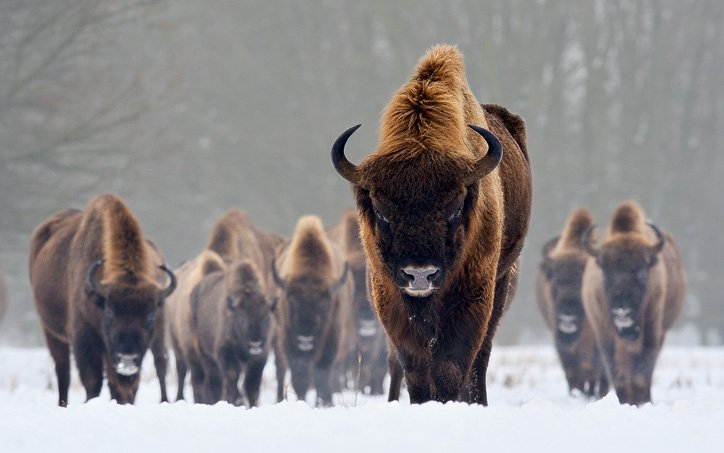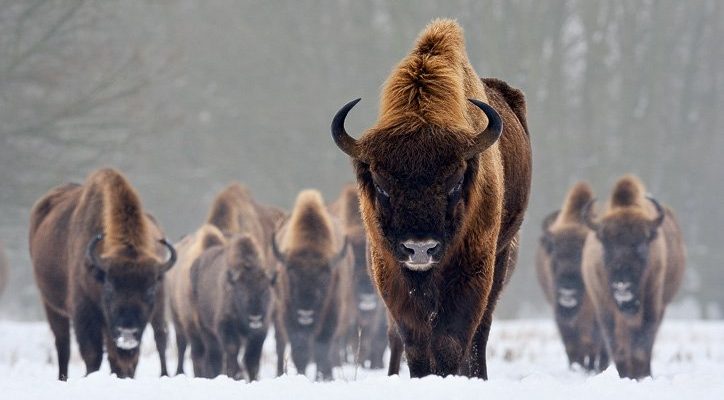
Imagine the European bison as a living legend—a character in an ancient tale that almost feels alive with the stories of those who came before us. From ancient Slavic myths to modern artistic representations, these animals have inspired paintings, sculptures, and even music. Now, let’s explore the rich cultural significance of the European bison, revealing why this magnificent beast holds a special place in human history.
The European Bison in Slavic Folklore
In Slavic culture, the European bison often symbolizes strength and nature’s spirit. Folklore from countries like Poland and Ukraine frequently depicts the bison as a guardian of the forest, embodying the wild, untamed essence of nature. In these tales, the bison is often celebrated for its bravery and noble presence. One popular story tells of a bison that leads lost travelers safely through the thick woods, reminding us that nature can be both a sanctuary and a guide.
Another fascinating aspect is the belief that seeing a bison can bring good luck. Folks would often recount tales of hunting bison, not just for their meat but also for spiritual reasons. The bison’s massive strength was revered, with hunters believing they would gain that same strength by respecting and honoring the animal. These stories, passed from generation to generation, highlight the deep bond between humans and bison, showing how intertwined their fates are.
Art and Literature Featuring the European Bison
The European bison has made its mark in various art forms throughout history. Artists have been drawn to this magnificent creature, capturing its beauty and awe on canvas. Think about paintings from the late 19th and early 20th centuries, where you might spot the bison depicted in a powerful stance against a backdrop of rolling hills or dense forests. These artworks often serve as a reminder of the wildness that still exists in our world, even as it becomes increasingly urbanized.
In literature, bison have inspired countless stories, often serving as symbols of freedom and the untamed spirit of nature. For example, in many fables, a wise old bison imparts lessons about humility, listening to the land, and finding harmony with surroundings. Writers use the bison to explore themes of survival and the struggle between man and nature, reminding readers of the importance of environmental preservation.
Mythical Interpretations and Symbolism
If you dive deeper into European mythology, you’ll find that the bison is often portrayed as a creature with mystical properties. Many tales suggest that the bison has the ability to communicate with spirits, acting as a bridge between the human world and the supernatural. In some myths, the bison is believed to carry messages from ancestors, guiding people through tough choices or decisions.
Additionally, the bison symbolizes resilience. It’s often depicted in stories reflecting the struggle against adversity, showing how strength can be found even in the harshest conditions. For instance, stories of bison wandering through winter storms or battling predators illustrate the importance of perseverance. This connection goes beyond mere storytelling; it’s a reminder of the resilience present in all of us, inspired by the mighty bison.
Contemporary Representations in Media
Fast forward to today, and the European bison continues to appear in various forms of media. Documentaries and wildlife shows highlight the bison’s natural habitat, documenting efforts to conserve and protect their populations. This educational angle emphasizes how crucial these animals are to biodiversity and the habitats they help maintain.
In films and animations, the bison is often featured as a character symbolizing courage. Think of films that portray the struggle for survival in the wild. The bison serves as a powerful totem, representing the spirit of the wilderness and the call to protect our natural world. By connecting with younger audiences, these representations keep the bison’s story alive, encouraging future generations to appreciate and advocate for wildlife conservation.
Regional Celebrations and Festivals
Across Europe, various regions celebrate the European bison through festivals and events. In Poland, for instance, there are annual cultural events focused on the bison, where locals gather to share stories, art, and music related to this magnificent creature. These festivals are often a riot of color and excitement, filled with traditional foods, crafts, and performances that pay homage to the bison’s role in their history and culture.
At these gatherings, you might see artistic representations of bison in the form of sculptures, paintings, or even dance performances. Each piece carries the essence of the bison, reinforcing its importance in local identity. Celebrating the bison this way fosters community spirit and deepens understanding of how interconnected nature, culture, and identity truly are.
Conservation Efforts and Symbolic Significance
As the European bison faces threats from habitat loss and hunting, its representation in culture takes on new meaning. Conservation efforts around the continent have become critical. There’s a recognition that protecting the bison is not just about saving a species; it’s about preserving a part of cultural heritage. Various organizations and communities are working together to ensure that the bison’s legacy continues.
This focus on conservation also helps rekindle interest in folklore related to the bison. As people become more aware of the bison’s plight, tales of strength, resilience, and connection to nature gain new relevance. They serve as reminders of what we stand to lose and why caring for our wildlife and environment is essential.
The European Bison in Modern Psychology
Interestingly, the European bison has also found a place in modern psychology and wellness practices. Some therapeutic programs use the bison as a symbol of strength and grounding, helping individuals reconnect with nature and their inner selves. This connection often emphasizes themes of mindfulness, encouraging individuals to take a step back and reflect on their lives.
Nature therapy sessions might include discussions about the bison’s powerful presence in the wild, illustrating how tapping into that strength can foster personal growth. This modern interpretation highlights how the bison is not just a relic of cultural past but also a present-day symbol of resilience and therapy, reminding us all of the healing power of nature.
In conclusion, the European bison holds a unique position in both cultural representations and everyday life. From folklore and art to contemporary conservation efforts, this incredible animal continues to inspire and connect us in many meaningful ways. By understanding its role in culture and the stories we tell, we can appreciate not just the bison, but also the interconnectedness of all life on earth. Embracing these narratives encourages us to protect these magnificent creatures for future generations, ensuring their story continues to thrive alongside ours.

